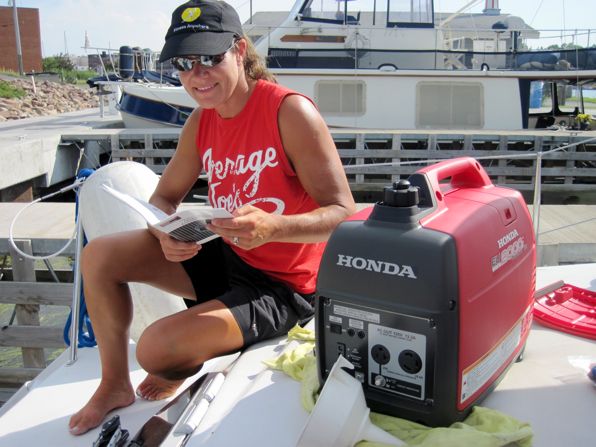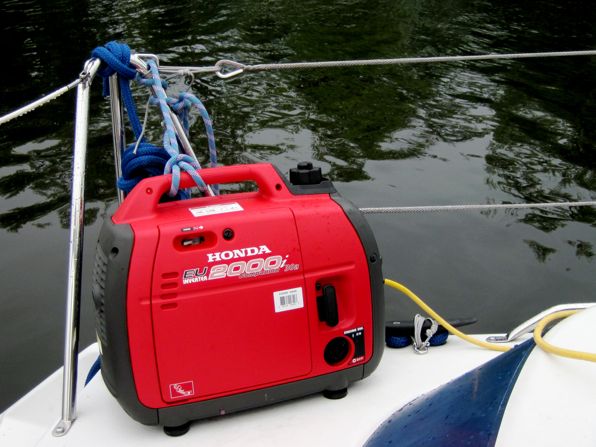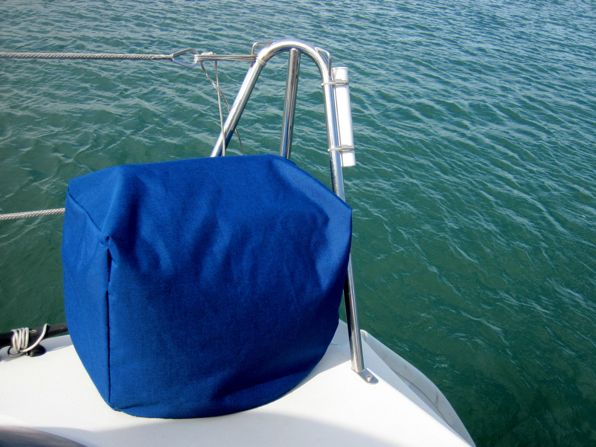Keeping Ronzo happy
It’s Friday morning, the rain is coming down hard and our Honda generator just ran out of fuel. Groan. Fortunately, the batteries are topped up enough that I don’t need to get out there right now, getting wet while filling it up again.
Outside of solar panels and wind generators, one really has four sources for battery charging when not underway:
- Shore power when on a dock
- Running the boat’s main engines
- Built in generators
- Small, portable generators
Comments on the above:
- Although some people live on the dock, this is not going to be available to us all that often.
- Diesel engines with big alternators certainly kick out a lot more amps than our little outboards. With that said, running the main engine solely to charge the batteries has to be the least efficient method available due to the wear and tear on the expensive engine.
- I don’t really have much to say about this other than they are expensive and we don’t have one. When we did our Liveaboard sailing course with Offshore Sailing, the Hunter 49 that we were on did have one on board and we ran it every night for an hour or two.
- Very, very popular with cruisers and although there are different brands and models available, the Honda 2000 is the gold standard that most everyone uses.
When we were back in Georgetown, we met a sailor with a lot of engineering experience who was very enamored with the Honda 2k. He shared with me some of his tips (I’ll mark them with an *) for keeping them running smoothly. Although I can’t comment on the how and why for all of these, we do follow his advice along with the tips we have gathered from other friends and sources.
- Lock the Honda to your boat! These would make nice carry-away gifts for thieves.
- Add corrosion inhibiting spray to all of the cover’s access bolts and screws. They will corrode in the salt water and at some point, you’re going to want to get into the case.
- In addition to the salt water/spray being hard on the unit, so is the sun. Many people, ourselves included, have sewn covers that we put over the generator when it is not in use. We have seen Honda 2000s where this was obviously not done and they are all faded pink.
- Filter all gasoline going in to the generator. Water and crap in the fuel will not make the Honda happy.
- Follow the manufacturers recommendations for oil, filter and spark plug changes. Duh!
- Overfill the oil slightly. The Honda 2k has a low oil sensor that will shut the unit down (I think) when it gets too low. When the unit is running on a moving boat, the motion of the waves can cause the oil to dip below this level, making the generator seem to sputter as it runs. Having a tiny bit more oil in the unit seems to stop this.*
- Every once in a while, run a liter or so of gas/2-cycle oil mixture through the engine (100:1, the same as used in most 2-stroke outboard engines). I can’t remember exactly what he said this did but we have been following his advice. I have also heard that people sometimes add Marvel’s Mystery Oil to the fuel, possibly getting the same effect.*
- There is a spark arrestor by the exhaust output which apparently gets clogged up. To clear it, occasionally do the following: While the engine is running, tightly hold a folded up rag over the exhaust (careful, it will be hot!) until the engines bogs down. Quickly remove the rag, letting the engine resume operating properly. Repeat this a number of times (half a dozen perhaps).*
- Always turn the choke on (close it) when the generator is off. We shut it down as follows: remove electrical output cord, close choke and then turn off fuel.*
Disclaimer: Although what I described above is what we do, do so at your own risk. Blah, blah, blah!

RTFM

Tethered and locked to the boat.

Rebecca sewed a nice Sunbrella cover for Ronzo


LOL @ RTFM :oD
So the Honda 2000 puts out 2000 watts (~16 Amps). When hooked up to your inverter / charger, how many amps do you actually see going to your batteries? I imagine it would take a long time to go from low to 80% charged?
Thanks!
The actual output is 13.3 Amps. With our 2000 Watt inverter/charger it takes perhaps an hour or a bit more to go from 50% charge to 90+%. Our battery monitor initially shows about 70-75 amps coming in and as the charge of the batteries goes up, that drops (a lot).
Here in Florida, we run two of these together to run our 14,000 BTU stand alone airconditioner at night on our Parker. Believe it or not, the two together make less noise than a single that is running at a higher RPM. We did rig a portable boat gas tank to feed fuel to the generator through a modified cap so we can run all night without re-fueling. It’s a compromise to keep us anchoring through our hot summers.
It doesn’t surprise me at all about the noise. They are extremely quiet at low revs but I think tad noisy at high revs. The guy that I mentioned that gave me the tips also had an external fuel tank rigged to his.
To run the two together I think one of them needs to be the companion model, right? That is the one we have but it also costs 100.00 more than the non-companion model.
Running generators in parallel takes a bit of caution.
The kind that have a synchronous inverter (I think the “companion” Honda is like this) can match their output phase and frequency to whatever power is already on the wire. This capability is also included in, for example, many modern Victron inverter/chargers that take both a shorepower and a generator input.
The kind that have a conventional sine inverter (most variable-speed portables) are best run on their own. Frying the inverter is a very real possibility if they’re connected together.
The old-style 1800 / 3600 rpm generators, without an inverter, will destroy each other if run in parallel. (The reactive load that they get when connected out-of-phase can literally snap a crankshaft in half.)
Your posts are always so… so… smart! 🙂
Thanks for posting, Matt.
Or you can get an “add on external parallel kit” http://www.mayberrys.com/parallel/parallel.htm
as we did for more $. We have two 2000’s that we got for huricane’s (and haven’t needded–yet!). I dont think the companion unit was available when we bought ours.
As regards your rope tether, I STRONGLY suggest that you use a wire or chain one, properly locked.
I have had mine stolen twice in the UK! Both times recovered by the Police!!
I now use a motorbike style safety chain with a combination lock on it, (no keys to lose). Mine is a strong wire thing covered with a plastic sheathing so rusting is minimal and the lock is integral and half decent.
No more problems – so far.
Cheers! Mike
Hi Mike
Sorry to hear that.
I agree.
Tip number one in the post: Lock the Honda to your boat! These would make nice carry-away gifts for thieves.
Note that it says tethered AND locked. I might not have the lock on it in that pic because we also sometimes store the generator out of sight in a lazarette when not in use.
At this moment it is definitely locked to the boat with a cable lock.
Ours usually only runs 30 mins to recharge our batteries from say 1235 amp to 1280. Going thru the three states of charging/accept/flood work well if the bank is only discharged at 1235. Anything less, because of the battery charger is rated at 100 amps., we have to run the diesel. The solar panel helped a bunch and most weeks we didn’t have to run the Honda just one day.
Not much sun happening here today. Rain, rain, rain.
FWIW
Here is the link to the yahoo Honda page if you don’t already have it.
Lot of knowledgeable people on there if you have a problem.
http://autos.groups.yahoo.com/group/Honda_EU2000_Generators/
Bill Kelleher
Excellent. Thanks Bill. I didn’t have that link.